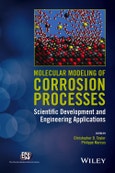Presents opportunities for making significant improvements in preventing harmful effects that can be caused by corrosion
- Describes concepts of molecular modeling in the context of materials corrosion
- Includes recent examples of applications of molecular modeling to corrosion phenomena throughout the text
- Details how molecular modeling can give insights into the multitude of interconnected and complex processes that comprise the corrosion of metals
- Covered applications include diffusion and electron transfer at metal/electrolyte interfaces, Monte Carlo simulations of corrosion, corrosion inhibition, interrogating surface chemistry, and properties of passive films
- Presents current challenges and likely developments in this field for the future
Table of Contents
List of Contributors vii
Foreword ix
Preface xi
1 An Introduction to Corrosion Mechanisms and Models 1
Christopher D. Taylor, Julian D. Gale, Hans-Henning Strehblow and Philippe Marcus
2 Molecular Modeling of Structure and Reactivity at the Metal/Environment Interface 35
Christopher D. Taylor
3 Processes at Metal–Solution Interfaces: Modeling and Simulation 65
Noelia B. Luque, Wolfgang Schmickler, Elizabeth Santos and Paola Quaino
4 Atomistic Monte-Carlo Simulations of Dissolution 99
Steve Policastro
5 Adsorption of Organic Inhibitor Molecules on Metal and Oxidized Surfaces studied by Atomistic Theoretical Methods 125
Dominique Costa and Philippe Marcus
6 Thermodynamics of Passive Film Formation from First Principles 157
Michael F. Francis and Edward F. Holby
7 Passive Film Formation and Localized Corrosion 191
Vincent Maurice, Alexis Markovits, Christian Minot and Philippe Marcus
8 Multiscale Modeling of Hydrogen Embrittlement 223
Xu Zhang and Gang Lu
Index 251








